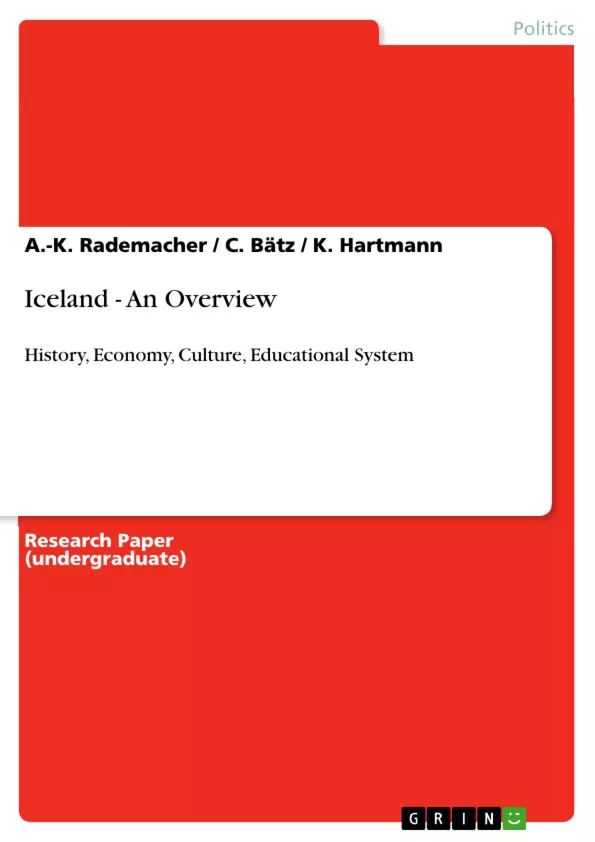We're selling Iceland," quoted the Financial Times in November 2007 after an interview
with Jon Olafsson, CEO of Icelandic Glacial. "The purity and coolness of the island -
because Iceland is very cool and hip these days." Though this statement is refered to the
water product, it demonstrated the high interest in the island itself. As many know, Iceland
is the country where one can witness the phenomenons of Mother Nature: tremendous
icecaps and several glaciers, raging rivers and magnificent waterfalls, spouting geysers
and steaming solfatara, volcanoes, a multitude of birds and whales. The spectacular
landscape is one reason why Iceland's tourism is successful. But in recent years Iceland
also drew the attention of many industries to itself. For example, many technological and
telecommuniational products have been outsourced in Europe towards Iceland as it
provides many competitive advantages in these fields.
Iceland is unique: it is the smallest economy in the world that has its own currency and a
flexible exchange rate. It is also an advanced country with excellent institutions meaning
low corruption index, the rule of law, a highly educated population and more (cf. Iceland
Chamber of Commerce 2006). For most of the 1990s the island presented one of the
highest consistent growth rates in the world and low inflation and unemployment.
Particularly the resource management in the mainstay fisheries sector, price stability and
diversification of the industry contributed to this economic record.
The paper on hand gives an outline of the country. To begin with general information
about the island is described. This includes demographic as well as historical and political
aspects. The third chapter sketches the development and structure of the Icelandic
economy. Current economic situation and main economic sectors are content of this
section. Furthermore, the culture is described with the three pillars being religion,
language and common history. Also the cultural dimensions of Hostede are analysed for
Iceland. Moreover this paper provides an overview of the Icelandic education system.
Finally upcoming topics and problems will be mentioned.
Inhaltsverzeichnis (Table of Contents)
- Preface
- Table of Contents
- List of Illustrations
- List of Abbreviations
- 1 Selling Iceland
- 2 General Characteristics of Iceland
- 2.1 Demographics
- 2.2 Iceland's Vegetation
- 2.3 Historical Development
- 2.4 Political System and International Relations
- 3 Economy and Industry of Iceland
- 3.1 Recent Economic Situation
- 3.1 Economic History
- 3.3 Structure of the Economy
- 3.4 The Main Economic Sectors
- 3.4.1 Financial Sector
- 3.4.2 Tourism
- 3.4.3 Marine Sector
- 3.4.4 Manufacturing and Power-Intensive Industries
- 4 Culture of Iceland
- 4.1 People and Society
- 4.2 Icelandic Language
- 4.3 Religion in Iceland
- 4.4 Icelandic Culture according to Hofstede
- 5 Educational System in Iceland
- 5.1 Pre-School (governed by the “the Pre-school Act”, No. 78/1994)
- 5.2 Compulsory Education (governed by the \"the Compulsory School Act\", No. 66/1995)
- 5.3 Upper-Secondary Level (governed by the \"the Upper Secondary School Act\", No. 80/1996)
- 5.4 Higher Education
- 6 Facts that Concern Iceland
- List of Literature
Zielsetzung und Themenschwerpunkte (Objectives and Key Themes)
This paper provides a comprehensive overview of Iceland, focusing on its general characteristics, economy, culture, and educational system. The authors aim to provide insights into the country's unique features and challenges, shedding light on its economic development and cultural identity.
- Iceland's unique geography, history, and cultural heritage.
- The economic situation and key industries in Iceland.
- The cultural landscape of Iceland, including language, religion, and societal norms.
- The structure and organization of the Icelandic educational system.
- Key facts and concerns related to Iceland's future prospects.
Zusammenfassung der Kapitel (Chapter Summaries)
Chapter 1 "Selling Iceland" introduces the reader to the diverse facets of Iceland, highlighting its captivating natural beauty, unique cultural experiences, and potential for economic growth. Chapter 2 delves into the general characteristics of Iceland, covering demographics, vegetation, historical development, and the political system. Chapter 3 provides a detailed analysis of Iceland's economy, examining recent economic trends, economic history, the structure of the economy, and the main economic sectors.
Chapter 4 focuses on the culture of Iceland, exploring aspects like the people and society, the Icelandic language, religion, and cultural values according to Hofstede's dimensions. Chapter 5 gives an overview of the educational system in Iceland, detailing pre-school, compulsory education, upper-secondary level, and higher education. Chapter 6 presents a selection of facts that raise concerns about Iceland's future, offering insights into potential challenges and opportunities.
Schlüsselwörter (Keywords)
Iceland, economy, culture, education, tourism, natural resources, sustainability, language, religion, Hofstede's cultural dimensions, economic development, societal norms, pre-school, compulsory education, upper-secondary level, higher education.
- Citation du texte
- A.-K. Rademacher (Auteur), C. Bätz (Auteur), K. Hartmann (Auteur), 2008, Iceland - An Overview, Munich, GRIN Verlag, https://www.grin.com/document/160358



